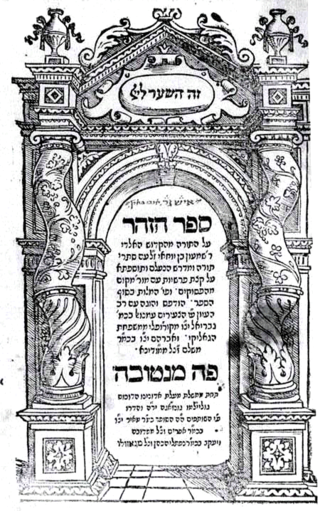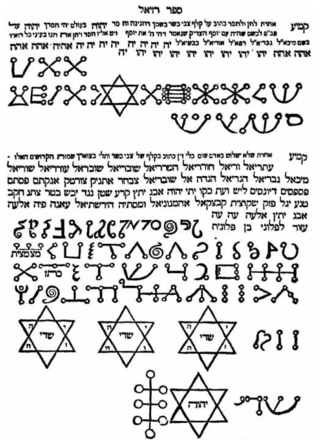Related Research Articles

The Zohar is a foundational work of Kabbalistic literature. It is a group of books including commentary on the mystical aspects of the Torah and scriptural interpretations as well as material on mysticism, mythical cosmogony, and mystical psychology. The Zohar contains discussions of the nature of God, the origin and structure of the universe, the nature of souls, redemption, the relationship of Ego to Darkness and "true self" to "The Light of God".

Rabbinic literature, in its broadest sense, is the entire spectrum of rabbinic writings throughout Jewish history. However, the term often refers specifically to literature from the Talmudic era, as opposed to medieval and modern rabbinic writings, and thus corresponds with the Hebrew term Sifrut Chazal. This more specific sense of "Rabbinic literature"—referring to the Talmudim, Midrashim, and related writings, but hardly ever to later texts—is how the term is generally intended when used in contemporary academic writing. The terms mefareshim and parshanim (commentaries/commentators) almost always refer to later, post-Talmudic writers of rabbinic glosses on Biblical and Talmudic texts.

Abraham ben Meir Ibn Ezra was one of the most distinguished Jewish biblical commentators and philosophers of the Middle Ages. He was born in Tudela, Taifa of Zaragoza.

Sefer haYashar is a medieval Hebrew midrash, also known as the Toledot Adam and Divrei haYamim heArukh. The Hebrew title "Sefer haYashar" might be translated as the "Book of the Correct Record", but it is known in English translation mostly as The Book of Jasher following English tradition. Its author is unknown.

Abraham ibn Daud was a Spanish-Jewish astronomer, historian and philosopher; born in Córdoba, Spain about 1110; who was said to have died in Toledo, Spain, a martyr about 1180. He is sometimes known by the abbreviation Rabad I or Ravad I. His maternal grandfather was Isaac Albalia. Some scholars believe he was the Arabic-into-Latin translator known as Avendauth.

Isaac Israeli ben Solomon, also known as Isaac Israeli the Elder and Isaac Judaeus, was one of the foremost Jewish physicians and philosophers living in the Arab world of his time. He is regarded as the father of medieval Jewish Neoplatonism. His works, all written in Arabic and subsequently translated into Hebrew, Latin and Spanish, entered the medical curriculum of the early thirteenth-century universities in Medieval Europe and remained popular throughout the Middle Ages.
Abraham ben David, also known by the abbreviation RABaDRavad or RABaD III, was a Provençal rabbi, an important commentator on the Talmud, Sefer Halachot of Rabbi Yitzhak Alfasi and Mishne Torah of Maimonides, and is regarded as a father of Kabbalah and one of the key links in the chain of Jewish mystics.
Moshe haDarshan was chief of the yeshiva of Narbonne, and perhaps the founder of Jewish exegetical studies in France. Along with Rashi, his writings are often cited as the first extant writings in Zarphatic, the Judæo-French language.

Josippon is a chronicle of Jewish history from Adam to the age of Titus. It is named after its supposed author, Flavius Josephus, though it was actually composed in the 10th century in Southern Italy. The Ethiopic version of Josippon is recognized as canonical by the Ethiopian Orthodox Tewahedo Church and the Eritrean Orthodox Tewahedo Church.

Sefer Raziel HaMalakh is a grimoire of Practical Kabbalah from the Middle Ages written primarily in Hebrew and Aramaic. Liber Razielis Archangeli, its 13th-century Latin translation produced under Alfonso X of Castile, survives.
Isaac Israeli ben Joseph or Yitzhak ben Yosef was a Spanish-Jewish astronomer/astrologer who flourished at Toledo in the first half of the fourteenth century.

Ishtori Haparchi (1280–1355), also Estori Haparchi and Ashtori ha-Parhi is the pen name of the 14th-century Jewish physician, geographer, and traveller, Isaac HaKohen Ben Moses.
Abraham ben Nathan was a Provençal rabbi and scholar of the 12th-13th centuries.
Isaac ben Joseph of Corbeil was a 13th-century French rabbi and tosafist, best known as the author of Sefer Mitzvot Ḳatan.
Isaac ben Samuel of Acre was a Jewish kabbalist who fled to Spain.
Moses ibn Tibbon was a Jewish physician, author and translator in Provence. The number of works written by Moses ibn Tibbon suggest that he reached a great age.
Moses ben Isaac ben ha-Nessiah of London was an English grammarian and lexicographer of the late twelfth and early thirteenth centuries. His mother was probably a Jew nicknamed Comitissa of Cambridge.
Sefer ha-Asuppot is the name of a compilation of medieval German Jewish halakha and minhagim, the manuscript of which is privately held by David H. Feinberg of New York. The work includes a large number of teachings, minhagim, descriptions of popular costumes, halachic rulings, and collected stories from numerous authors, displaying the ordinary life of Rhineland Jews in during the twelfth and thirteenth centuries. The manuscript is endowed with vowel signs almost throughout, which makes it the only non-liturgical and non-Biblical text of its kind, and the vowels follow the Spanish pronunciation. The manuscript is the work of several scribes, containing multiple hands and multiple inks. One scribe was probably named Meir.

Shlomo ben Afeda Ha-Kohen or Solomon Afeda Cohen (1826–1893) was a Karaite Jewish hakham of the 19th century considered the last of the Karaite sages of Constantinople.
Moses ben Eliezer Cohen was a Jewish writer and moralist who lived in Germany, probably at Coblenz, in the second half of the 15th century.
References
- ↑ "Latif, Isaac b. Abraham ibn".
- ↑ p.98/4:4, p. 104/4:13, p.108/5:1
- ↑ "ALLATIF, ISAAC BEN ABRAHAM IBN LATIF".
- ↑ "Tsurat ha-olam - Isaac ben Abraham Ibn Latif". 1860.
- ↑ "Latif, Isaac ben Abraham ibn approximately 1220".
- ↑ "Manuscript – Tzurat HaOlam by Rabbi Yitzchak Ibn Latif and an Unidentified Work on the Torah – Beginning of 15th Century".
- ↑ "Sefer Rov Poalim (Hebrew Edition): Yitzhak Ibn Latif".
- ↑ "ספר פעלים". 1885.
- ↑ "Moses ben Isaac Ibn Latif".
- Shoey Raz: Latif, Isaac b. Abraham ibn. In: Encyclopaedia Judaica , 2. edition, Vol. 12, Detroit 2007, pp. 506–507 (online)
- Dan Cohn-Sherbok: Medieval Jewish Philosophy. Routledge 1996, ISBN 0-7007-0414-0, pp. 117–119 ( online copy , p. 117, at Google Books)
- Harvey J. Hames: The Art of Conversion: Christianity and Kabbalah in the Thirteenth Century. Brill 2000, ISBN 90-04-11715-6, pp. 56–57 ( online copy , p. 56, at Google Books)